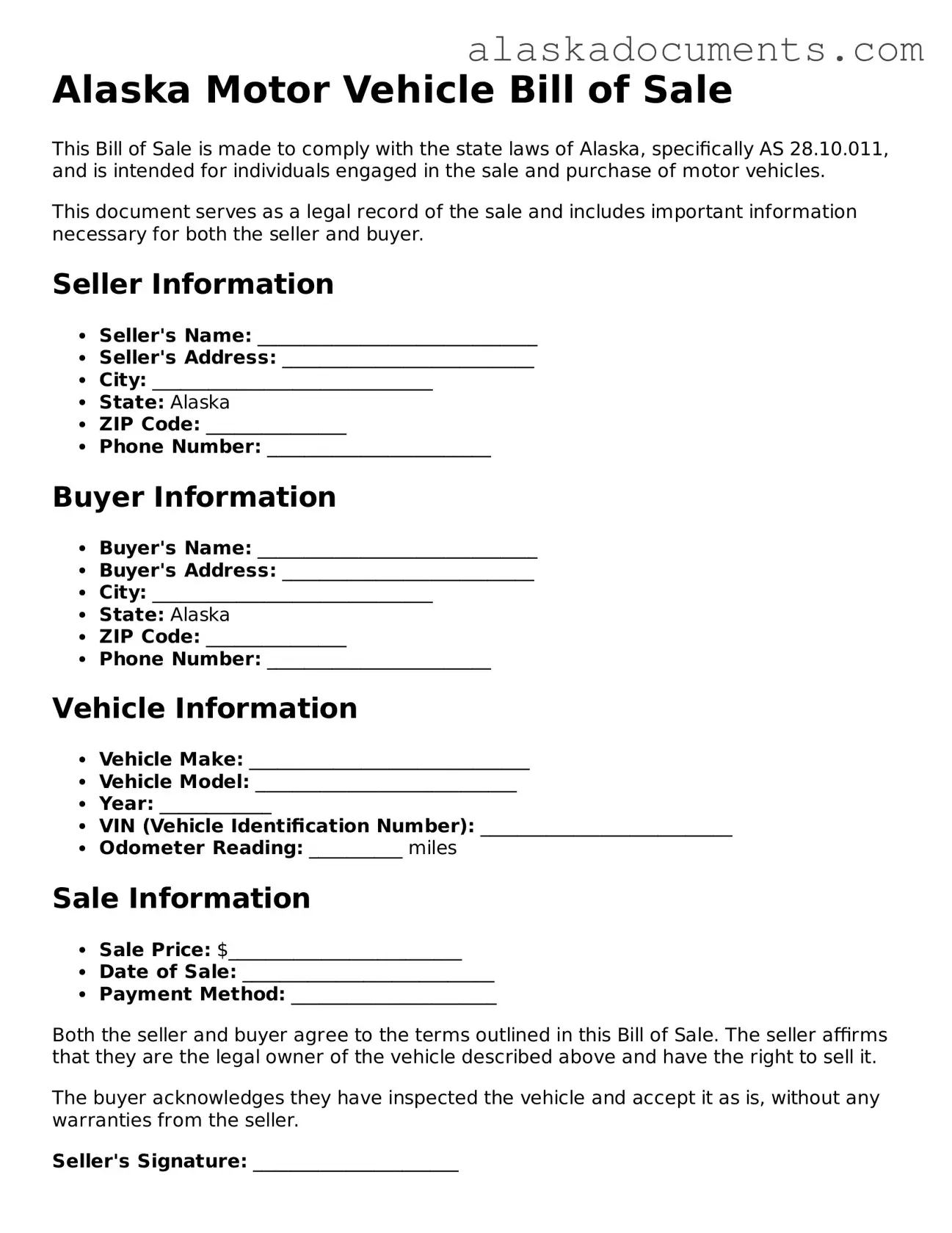The Alaska Motor Vehicle Bill of Sale form shares similarities with the general Bill of Sale, a document used across various states to transfer ownership of personal property. This form typically includes details about the seller, buyer, and the item being sold, such as a vehicle. Both documents serve to legally establish the transaction and protect the interests of both parties. Additionally, they often require signatures from both the buyer and seller, ensuring mutual agreement on the terms of the sale.
Another document that resembles the Alaska Motor Vehicle Bill of Sale is the Vehicle Title. The title serves as proof of ownership and includes essential information about the vehicle, such as its make, model, and Vehicle Identification Number (VIN). When a vehicle is sold, the title must be transferred to the new owner, often requiring a bill of sale as part of the process. Both documents are crucial for confirming ownership and facilitating the registration of the vehicle with the state.
The Odometer Disclosure Statement is another document that aligns closely with the Alaska Motor Vehicle Bill of Sale. This form is often required when a vehicle is sold, detailing the odometer reading at the time of sale. Both documents aim to provide transparency in the transaction, helping to prevent fraud related to the vehicle's mileage. Sellers must accurately report the odometer reading, and buyers should keep this statement as part of their records.
Similar to the Alaska Motor Vehicle Bill of Sale is the Purchase Agreement. This document outlines the terms of the sale, including the purchase price, payment method, and any warranties or conditions. While a bill of sale focuses primarily on the transfer of ownership, the purchase agreement often includes more detailed provisions about the transaction, making it a complementary document in vehicle sales.
The Release of Liability form is also comparable to the Alaska Motor Vehicle Bill of Sale. This document serves to notify the state that the seller is no longer responsible for the vehicle after the sale. By submitting this form, the seller protects themselves from future liabilities associated with the vehicle. Both documents work together to ensure that the transaction is officially recognized and that liability is appropriately transferred to the new owner.
The Application for Title and Registration is another document that bears similarity to the Alaska Motor Vehicle Bill of Sale. This form is necessary for registering the vehicle under the new owner's name after the sale is completed. It typically requires information from both the bill of sale and the vehicle title, ensuring that the ownership transfer is recorded accurately with the state. Both documents are essential for legally operating the vehicle on public roads.
The Warranty Deed, while typically associated with real estate, shares a conceptual similarity with the Alaska Motor Vehicle Bill of Sale in that both documents are used to transfer ownership. A warranty deed provides assurances about the title being clear of liens or claims. Similarly, the bill of sale confirms that the seller has the right to sell the vehicle and that it is free from undisclosed issues, ensuring a smooth transfer of ownership.
If you are operating a business in Arizona, it's essential to stay compliant with state regulations, including the timely submission of the Arizona Annual Report form, which provides an overview of your company's activities and ensures that you maintain good standing with the Arizona Corporation Commission.
The Affidavit of Heirship is another document that can be related to the Alaska Motor Vehicle Bill of Sale in cases where a vehicle is inherited. This affidavit serves as a legal declaration that the person claiming ownership of the vehicle is an heir. When transferring ownership, both the affidavit and the bill of sale may be required to establish rightful ownership and facilitate the transfer process.
The Donation Receipt is similar to the Alaska Motor Vehicle Bill of Sale when a vehicle is donated rather than sold. This document serves as proof of the donation and may include details about the vehicle and its fair market value. Both the donation receipt and the bill of sale document the transfer of ownership, although one is for charitable purposes rather than a financial transaction.
Lastly, the Salvage Title is a document that may be associated with the Alaska Motor Vehicle Bill of Sale when a vehicle has been deemed a total loss by an insurance company. This title indicates that the vehicle has been repaired and is now roadworthy. Both documents are important for ensuring that the new owner is aware of the vehicle's history and any potential issues, thus facilitating a transparent transaction.
